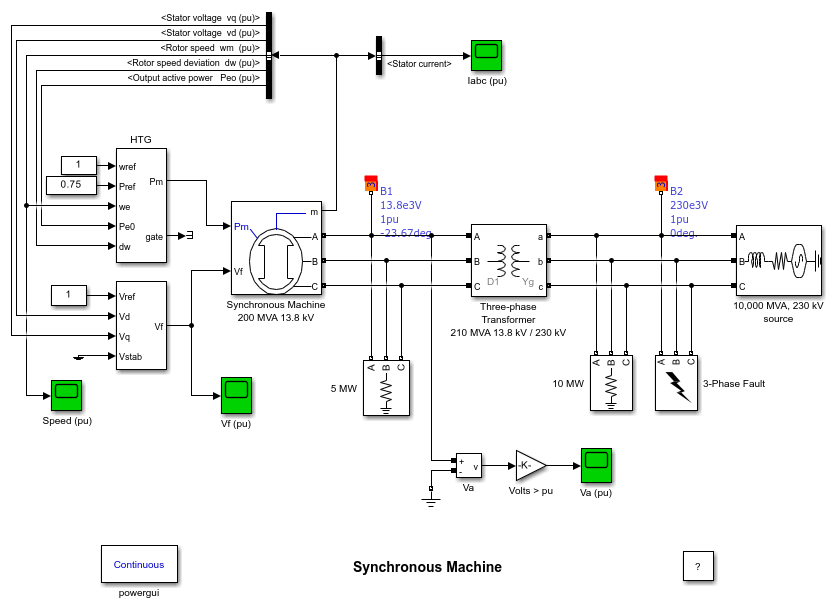本页面提供的是上一版软件的文档。当前版本中已删除对应的英文页面。
同步电机
此示例展示了如何使用 Powergui 的 Machine Initialization 工具来初始化电机电流。
Louis-A. Dessaint 和 R. Champagne(蒙特利尔高等技术学院)

描述
一台额定值分别为 200 MVA、13.8 kV 和 112.5 rpm 的三相发电机,通过一台 210 MVA 的三角型-星型变压器连接到 230 kV、10,000 MVA 的电网。在 t = 0.1 秒时,230 kV 母线上发生三相接地故障。故障在 6 个周期后(t = 0.2 秒)被清除。
仿真
1.打开 Powergui 并选择 Machine Initialization。此时将显示一个新窗口。电机的 Bus type 被初始化为 PV generator,这表明初始化过程中电机被设置为控制有功功率及其端电压。所需的端电压参数设置为 13800,有功功率设置为 150e6。*
按 Compute and Apply 按钮。AB 相和 BC 相电机电压的相量以及流出 A 相和 B 相的电流将更新。此外,还会显示提供电力所需的电机无功功率、机械功率以及励磁电压:Q = 3.4 Mvar;Pmec = 150.32 MW (0.7516 pu);励磁电压 Ef = 1.291 pu。
2.为了在连接 HTG 和励磁系统的情况下以稳态开始仿真,这两个模块需根据 Machine Initialization 工具计算出的值进行初始化。只要在电机的 Pm 和 Vf 输入端连接 Constant 模块或电机库中的调节模块(HTG、STG 或 Excitation System),系统就会自动执行此初始化。打开 HTG 模块菜单后,您可以看到,该工具已将初始机械功率设置为 0.7516 pu (150.32 MW)。打开 Excitation System 模块菜单后,您可以看到,初始端电压和励磁电压分别被设置为 1.0 pu 和 1.29071 pu。
3.打开 4 个示波器并重新开始仿真。您可以看到,仿真开始时端电压 Va 为 1.0 pu。故障期间,端电压降至约 0.4 pu,在故障清除后迅速恢复到标称值。端电压的这种快速响应是由于励磁系统输出电压 Vf 即使在故障期间也可高达 11.5 pu。故障期间,电机转速增至 1.01 pu,然后随着调速器系统的调节,转速围绕 1 pu 振荡。转速稳定所需的时间比端电压的要长得多,这主要是因为调速器系统中阀门的开启/闭合速率限制为 0.1 pu/s。